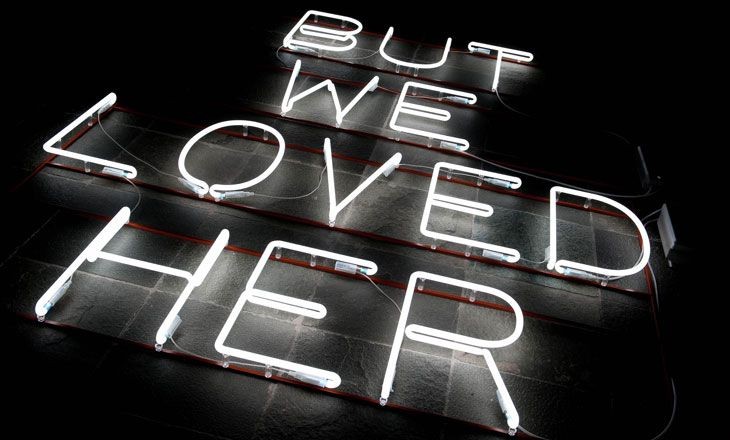Ursula Mayer
13 Oct 2013 - 12 Jan 2014
URSULA MAYER
But We Loved Her
13 October 2013 - 12 January 2014
BUT WE LOVED HER – the title of Ursula Mayer’s exhibition was taken from a picture in the April 17, 2013 issue of the British daily paper The Independent, the day Margaret Thatcher was interred. The London-based artist collected all the newspaper articles in the days that followed Thatcher’s death, programmatically positioning these four words at the forefront of her exhibition in Vienna, and in a phase of her work that foregrounds questions about the opportunities offers by neoliberal identity, about consumer culture in a post-capitalistic society, and about their precursors. Based on sources from film, philosophy, politics and culture, Ursula Mayer recombines idea-historical texts and images, developing a multi-layered mesh of autonomous statements and concepts. Her work explores strategies of cinematic image creation which cement social norms so as to expose the structure, alter, and represent exactly these conventional images through the deconstruction of the filmic language.
The point of departure for the large institutional solo exhibition by Ursula Mayer and simultaneously the first joint exhibition project between the Ursula Blickle Stiftung and the 21er Haus is a trilogy of the films GONDA (2012), MEDEA (2013) and the 16mm double-projected Cinesexual (2013). The central characters, model Valentijn de Hingh and musician JD Samson, embody versions of such diverse figures as Ayn Rand, Margaret Thatcher, Medea and Jason, ultimately converging with Michael Snow in a Two Sides to Every Story reference, drawing all the threads together. It is a threshold situation staged to dissolve the oppositions of a binary world-view. Mayer’s actualization of fundamental social topics spans time from the ancient migration story of Euripides’ Medea to the riots in the Arab world today, and insistently investigates the current conditio humana. It explores questions of individuality and personal freedom, of emotion and the ultimate limit state of human destructivity. The film scripts written by author and art critic Maria Fusco and film theorist Patricia MacCormick are based on original source material and pull the viewer into the sensual world of cinematic narrative while catapulting him or her instantaneously into the individualist present day. The films are transported into the exhibition space in a tableau vivant of different objects and scenarios, such as the body machines of Bruno Gironcoli which embroil beholder in the spell of its social and psychological entanglements. The hidden hints and coded clues guide his perception along a labyrinth path of sensual and intellectual seduction.
But We Loved Her
13 October 2013 - 12 January 2014
BUT WE LOVED HER – the title of Ursula Mayer’s exhibition was taken from a picture in the April 17, 2013 issue of the British daily paper The Independent, the day Margaret Thatcher was interred. The London-based artist collected all the newspaper articles in the days that followed Thatcher’s death, programmatically positioning these four words at the forefront of her exhibition in Vienna, and in a phase of her work that foregrounds questions about the opportunities offers by neoliberal identity, about consumer culture in a post-capitalistic society, and about their precursors. Based on sources from film, philosophy, politics and culture, Ursula Mayer recombines idea-historical texts and images, developing a multi-layered mesh of autonomous statements and concepts. Her work explores strategies of cinematic image creation which cement social norms so as to expose the structure, alter, and represent exactly these conventional images through the deconstruction of the filmic language.
The point of departure for the large institutional solo exhibition by Ursula Mayer and simultaneously the first joint exhibition project between the Ursula Blickle Stiftung and the 21er Haus is a trilogy of the films GONDA (2012), MEDEA (2013) and the 16mm double-projected Cinesexual (2013). The central characters, model Valentijn de Hingh and musician JD Samson, embody versions of such diverse figures as Ayn Rand, Margaret Thatcher, Medea and Jason, ultimately converging with Michael Snow in a Two Sides to Every Story reference, drawing all the threads together. It is a threshold situation staged to dissolve the oppositions of a binary world-view. Mayer’s actualization of fundamental social topics spans time from the ancient migration story of Euripides’ Medea to the riots in the Arab world today, and insistently investigates the current conditio humana. It explores questions of individuality and personal freedom, of emotion and the ultimate limit state of human destructivity. The film scripts written by author and art critic Maria Fusco and film theorist Patricia MacCormick are based on original source material and pull the viewer into the sensual world of cinematic narrative while catapulting him or her instantaneously into the individualist present day. The films are transported into the exhibition space in a tableau vivant of different objects and scenarios, such as the body machines of Bruno Gironcoli which embroil beholder in the spell of its social and psychological entanglements. The hidden hints and coded clues guide his perception along a labyrinth path of sensual and intellectual seduction.

